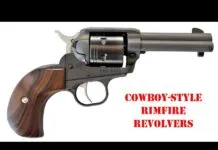We tested two 380 ACP handguns in the April 2013 issue. Here’s an excerpt of that report.
If you have a handgun for what some consider to be a sub-caliber round, it might be comforting to have lots of shots on hand, because you just might need them. Taking our tongues out of our cheeks now, the 380 can be an effective self-defense handgun cartridge, particularly with today’s hotter JHP loads — if you can find any. There are zillions of good used 380s out there, though in today’s market you might have the devil of a time finding one. We managed to acquire two, both slightly used, just like what you might have to consider in today’s super-tight gun market.
Our test pistols were a Beretta Model 84 ($600-$650) and a CZ Model 83 ($550 on up). Both were DA/SA pistols. Their size was about that of the two 40-cal pistols we tested recently here in Idaho, the S&W M&P 40 Compact and the Kahr CW40 (March 2013). Most of the small nines we’ve been testing are considerably smaller than these two 380s. We wouldn’t call either of them pocket guns. They’d fit a purse or a decent holster nicely, though. They both had fat grips, so they’ll bulge the concealment clothing somewhat more than a 45 auto.
These two guns were uncannily alike in some ways, though of completely different designs by two proud old makers. Although both were DA/SA guns, they could be carried cocked and locked. They had ambidextrous safeties and external hammers. They had staggered magazines that held 12 or 13 rounds. Their two-quick-shot, DA/SA feels were so much alike we could not tell a difference. Both were simple blowback actions, with enough mass to their slides that they didn’t require barrel-locking mechanisms. The slides simply reciprocate after each shot and the barrels never move. Both had metal frames, a breath of fresh air, we thought, in today’s plastic-dominated market.
Like the rest of the world, we currently have a shortage of common ammunition here in Idaho, so we had to test this pair of 380s with just one type of ammo, 95-grain FMJ, in two persuasions. Most of that fodder has about the same ballistics, so what we got is about what you’d expect from anything you might find of a similar nature. Cor-Bon makes hotter 380 JHP ammo, as does Federal and a few others, but none was available to our test team at this writing. Here’s what we found.
CZ Model 83 380 ACP, about $550
This model was discontinued in 2012, and its last listed price was $452. At first, we wondered why in the dickens CZ stopped making it, but we think we found out why when we opened it up. So far as we can tell, CZ-USA no longer offers any 380 pistols at all. We tested one of these in 2010 and it got our highest recommendation. This test gun was slightly used, and considerably older than the other one. It had modest bluing wear on the sides of the slide near the muzzle, and a few other signs of light wear. The all-steel frame gave this gun somewhat more weight than the Beretta.
Though the CZ 83 had some smoothed-off checkering molded into its plastic grip panels, its grips were about as slick as those on the Beretta. The trigger guard bordered on huge, so this one might be the better choice if you like to shoot wearing heavy winter gloves. Although the CZ had a spur hammer, we didn’t find it any easier or harder to thumb cock than the other gun. Its sights were a little bigger and bolder than the Beretta’s. Again, the sights were all steel. The front blade was pinned in and could be replaced to change elevation to suit your best choice of ammo. Like the other gun’s sight, the rear was driftable for windage.
The CZ’s ambi safety could not be put on with the hammer down. Therefore, the CZ was always ready to shoot if you had a round in the chamber with the hammer down: Pull the gun and press the trigger. The Beretta’s safety could be put on with the hammer down: Pull the gun and wonder why it won’t shoot. The CZ’s hammer was rebounding, and could not reach the firing pin unless the trigger was fully back. Neither could the Beretta’s, though the Beretta had a half-cock position. We found the CZ’s safeties not as easy to use as those on the Beretta. They were stiff. The CZ’s magazine could be dropped either by using the index finger or the thumb. Thus it was ambidextrous. We found it easier to use the index finger because the grips bulged and blocked our thumb. The Beretta’s mag release can apparently be reversed if desired. The magazines of both guns dropped free when released.
Takedown of the CZ 83 is similar to that required for the Walther PPK. With the gun clear and the magazine out, the trigger guard is pulled forward and down until it clicks into the takedown position. Then the slide is pulled rearward, lifted, and eased forward off the frame. The recoil spring circles the barrel, like that of the PPK. The barrel is pinned to the receiver. A good look at the innards of this gun revealed good reasons for its discontinuance. There are a great many parts inside, all of ‘em machined. We suspect CZ was losing money on this one. The ejector, for instance, looks hefty enough to eject 50-caliber Browning rounds. It’s part of another piece that’s pinned into the gun, and was machined on all surfaces. It had its sharp edges all carefully deburred, apparently by hand. We did not see any investment castings in this gun. The safety levers and the slide stop, with their nicely serrated operating surfaces, were all machined. The magazine release was machined. The hammer and trigger, ditto.
Though some parts may have started life as castings, we could not find any parting lines on any of the gun’s myriad parts. This was old-world gunmaking. The Beretta was made much the same way, but in the Cheetah we saw what could have been some castings, and that gun had nowhere near the number of parts contained within the CZ.
We were impressed by the intricacy of this design. It wasn’t beautifully finished inside, but the work was well done and extremely sturdy looking. If you compare it to a modern S&W M&P with all its stampings, the M&P parts look too small, yet we know they work very well. We suspect this overbuilt CZ will last a long time.
Although the recoil of these 380s must be judged to be relatively insignificant, on the range we found the recoil of the CZ to be sharper than that of the Beretta despite the CZ’s greater weight. The line of recoil is the same height above the hand. We cannot explain this, yet there it is. Like the Beretta, the CZ shot close enough to its sights that we could not complain.
Our Team Said: We got about the same degree of accuracy with the CZ as with the Beretta, groups on the order of 2.5 to 3 inches at 15 yards. There were no problems at all with the gun. It fed, fired, and ejected perfectly, though ejection was not all that far from the gun. Again, we had fun shooting it fast, so if you buy one of these, be sure to stock up on ammo (good luck with that) because we think you’ll like shooting it too. We downgraded it for the lack of traction on the grips. That might not be significant to you, but we guarantee when your hands are sweaty, you’ll wish for a better grip on the gun.





























